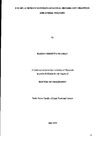THE RELATIONSHIP BETWEEN LIVESTOCK DISTRIBUTION CHANNELS AND ANIMAL WELFARE
| dc.contributor.author | MURRAY, KAREN CHRISTINA | |
| dc.contributor.other | Faculty of Science and Engineering | en_US |
| dc.date.accessioned | 2013-10-31T10:02:23Z | |
| dc.date.available | 2013-10-31T10:02:23Z | |
| dc.date.issued | 2001 | |
| dc.identifier | NOT AVAILABLE | en_US |
| dc.identifier.uri | http://hdl.handle.net/10026.1/2494 | |
| dc.description.abstract |
Major changes are taking place in all sectors of the livestock and meat producing industries from farm to consumer which impinge on the processes and patterns of livestock distribution from farm to slaughter. These changes are identified and described. A survey of the complete journeys from farm to abattoir of 18,393 slaughterweight lambs sold direct from farm to abattoir, via livestock auction markets and via electronic auctions was conducted. Lambs sold direct from farm to abattoir experienced shorter journeys (in terms of both median duration and distance) than lambs sold through either of the other two channels. Lambs sold through electronic auctions, on average, travelled longer distances but for shorter times than lambs sold through livestock auction markets. Although these results are broadly consistent with the common perception of direct sale lambs experiencing simpler journeys than lambs passing through the other channels, they do not support this view unequivocally. The journeys were diverse in all three distribution channels and ranged from direct and uninterrupted transfer from farm to abattoir (n=4,888) to highly complex itineraries including up to three periods of transportation interspersed with two holding periods at assembly points, staging posts or auction markets (n=l,034). Journeys also included those with between 2 and 8 pickups en route (n=2,369), and those involving holding at assembly points, staging posts or livestock auction markets before transfer to abattoir (n=10,102). A total of 26 different journey structures were identified: 18 in direct farm to abattoir sales, 9 in sales via livestock auction markets and 13 within the electronic auction system. The effect of journey structure on the welfare of slaughterweight lambs (90 transported and 45 non-transported controls) was investigated in an experiment comprising 3 journey types (direct transfer from farm to abattoir, a journey involving 3 additional pickups en route and a journey incorporating holding at a livestock auction market) with non-transported controls held in a pen for the duration of the transport period. Transportation per se affected the liveweight and behaviour of the lambs: transported lambs lost more weight during the transport period and spent less time ruminating and less time lying down than non-transported lambs. Multiple pickup and Market lambs lost more weight and spent less time ruminating whilst lying than Direct lambs. Ultimate carcase pH (pHu) was higher for Multiple pickup and Market lambs than Direct lambs. There were no differences in liveweight loss, ruminating behaviour or pHu between Multiple pickup and Market lambs. Direct and uninterrupted transfer from farm to abattoir is preferable to more complex itineraries, but it is essential to consider journey structure, rather than simply the marketing channel, when judging the impact of livestock transport on animal welfare. | en_US |
| dc.language.iso | en | en_US |
| dc.publisher | University of Plymouth | en_US |
| dc.title | THE RELATIONSHIP BETWEEN LIVESTOCK DISTRIBUTION CHANNELS AND ANIMAL WELFARE | en_US |
| dc.type | Thesis | |
| plymouth.version | Full version | en_US |
| dc.identifier.doi | http://dx.doi.org/10.24382/1600 |
Files in this item
This item appears in the following Collection(s)
-
01 Research Theses Main Collection
Research Theses Main


